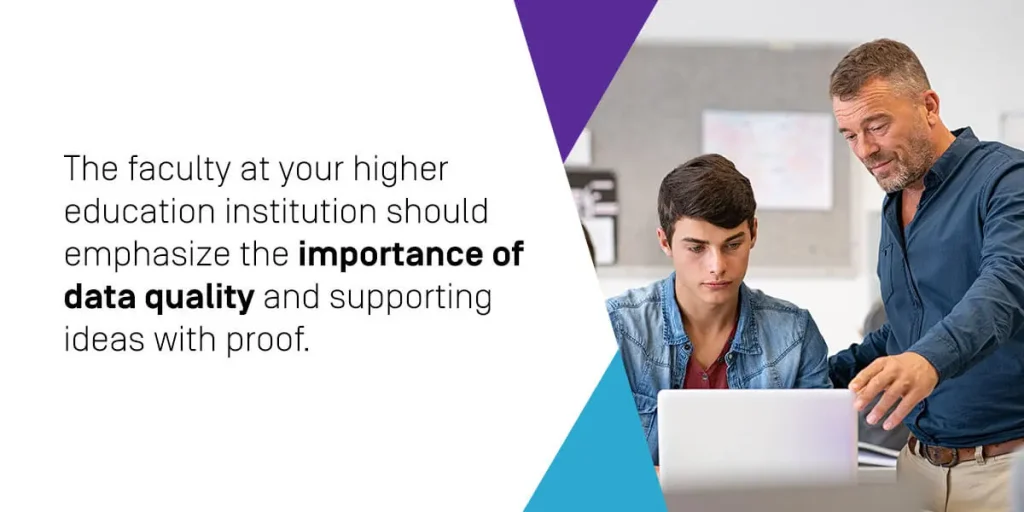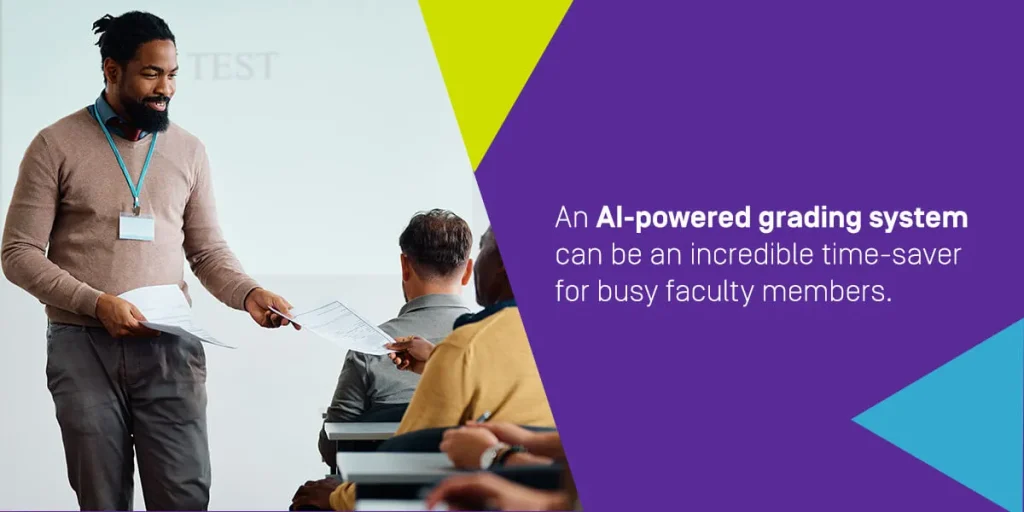




As artificial intelligence (AI) becomes an increasingly important part of higher education, your institution’s instructors must find responsible ways to adopt and share these tools.
The introduction of AI should be strategic and mindful to avoid common pitfalls, like amplifying biases or leaving student data unprotected. How your institution approaches higher education AI adoption will impact the integrity of your programs, so understanding the best practices is essential for supporting positive learner outcomes.
Your university or college can foster a culture of responsible AI use with careful forethought and planning. We are sharing different ways your faculty can capitalize on AI without sacrificing quality student experiences.
Your higher education institution has a duty to introduce and embrace artificial intelligence in a beneficial and trustworthy manner. Creating clear guidelines and promoting the ethical use of these advanced technologies will help your college or university maximize the benefits of leveraging AI while minimizing the potential repercussions.
Responsible instructor AI adoption is essential for:
A 2023 study revealed that 56% of college students admitted to using AI to complete their coursework and assignments. With learners already actively utilizing these tools, understanding the role of AI and sharing policies for students and staff can help your institution protect academic integrity.
Students are responsible for turning in original work that accurately cites their sources and is free of plagiarism. They must learn how to use AI as a supplementary tool rather than a shortcut. Responsible AI adoption is key to maintaining high standards for academic integrity at your institution.
How your organization handles AI adoption will impact equity and inclusion across campus. There are various ways for your institution to do this:
As artificial intelligence becomes a more significant part of society, colleges and universities will benefit from staying at the forefront of these advancements. This technology is revolutionizing how many industries operate. Higher education institutions can prepare students for a future of interacting and working with these tools by providing education on best practices. Embracing new tech can help your institution evolve and ultimately equip students with the insights they need for success.
Higher education institutions can optimize AI adoption by following a few best practices:
College or university faculty should discuss artificial intelligence openly with their students, especially relating to the acceptable uses of AI for class. Fostering an ongoing conversation about the implications of these modern technologies can help your community understand AI’s role in the future of both education and the working world.
Highlight the value and importance of producing original work, especially in an academic or professional context. Discuss AI as a tool to support the learning process rather than something that replaces the need for diligent research and work.
Share the potential drawbacks of artificial intelligence, such as:
Generative AI tools are not fool-proof and will sometimes offer false or irrelevant insights. Users shouldn’t rely on AI alone. They should verify their results with critical thinking and do their due diligence.
The faculty at your higher education institution should emphasize the importance of data quality and supporting ideas with proof. A student’s ability to provide data-backed evidence and demonstrate good analytical skills will benefit their success in and out of the classroom.
When using AI-powered systems to automate administrative tasks like tracking class attendance or grading quizzes, your instructors should always review the data to ensure accuracy and fairness.

Your faculty should be selective about the AI tools they utilize and the platforms they allow students to use for class work. Each solution has different capabilities, limitations, and costs.
Ensure your instructors are purposefully and deliberately selecting AI tools. The options they choose should align with the specific assignment or activity. They should also enhance the course’s overarching learning objectives and help students gain a stronger understanding of class content. They should look for tools that empower students to think critically, enhance creativity, and help them apply essential topics.
An important element of responsible faculty AI adoption is fostering transparency about using these solutions with students. Higher education institutions can benefit from taking a human-centered approach to implementing new technologies. Your instructors should be honest about how they are utilizing AI to support the operations in their classroom. Ensure they explain how these tools are there to enhance learning experiences and not replace them.
Fostering an open conversation about artificial intelligence across campus is key to reaping the most benefits and creating a culture of continuous improvement and innovation.
Ongoing monitoring and refining is an important part of using AI tools effectively. The models your instructors use should be continuously improved and updated to deliver the most accurate, comprehensive and timely results for your institution’s users.
Your faculty should have protocols to follow regarding ongoing learning and retraining their AI models as new data emerges and the tool’s capabilities advance. Higher education institutions should prioritize gathering regular feedback from students and faculty to identify new opportunities to enhance the AI tools your community uses.
Every faculty member who utilizes artificial intelligence must understand the necessity of strong data privacy and security practices.
Your instructors should always get consent before obtaining and using student data. They should also prioritize keeping that information safe and communicating its purpose and uses with students.
How your faculty members collect, store, share, and analyze data matters. They can combat many AI-related threats by ensuring they work with secure platforms that have adequate security measures, like strong access controls and data encryption.
Your higher education institution must develop comprehensive artificial intelligence guidelines to ensure your faculty utilizes these tools ethically. These guidelines should include:
In addition to understanding the moral implications of artificial intelligence, your instructors should also communicate the importance of responsible AI and data use.
Having the right policies in place will help your faculty navigate fair AI utilization and educate students about leveraging these solutions ethically.
The faculty at your higher education institution will benefit from continuously assessing the AI tools they use in terms of effectiveness, performance, and the results they provide.
The purpose of introducing AI to the classroom is to support and improve educational outcomes. By evaluating their impact, your instructors can ensure they use effective, ethical tools that enhance academic achievement.
Using AI can help your faculty manage their workloads, enhance academic research, inform advisement, and stay on the cutting edge.
Explore responsible AI uses for instructors below:
A great way to utilize AI is by analyzing student data for personalized learning recommendations.
Your faculty would have to spend days on end analyzing the past performance of each student, getting to know their specific learning style and suggesting tailored materials for each person. AI allows instructors to provide more individualized attention without overwhelming them with additional work and research. They can use automated tools to generate adaptive course materials and access analytical tools to track each student’s pace and learning needs.
AI can help your institution’s instructors align teaching practices with student preferences to support improved learning and performance outcomes.
An AI-powered grading system can be an incredible time-saver for busy faculty members. These solutions can automate the review and scoring process for homework assignments, quizzes, and exams. AI tools with advanced natural language processing capabilities can even analyze written responses.
Instructors can save significant time with these systems, and students can benefit from getting feedback sooner. An important element of responsible AI adoption is ensuring your faculty continues to monitor these systems and their limitations. They should continue to give each student’s work the necessary time and attention to support optimized learning outcomes.

Another way your instructors can capitalize on artificial intelligence is by utilizing automated virtual teaching assistants. These AI-powered solutions make it possible for students to access support and help with their coursework around the clock. Instructors don’t have to spread themselves too thin to provide additional tutoring to struggling individuals. The right tool can help students find the information and clarification they need to succeed in class.
Your faculty members should closely monitor these solutions and provide guidance to students on how to use them effectively. Instructors should not rely solely on AI assistants to offer support outside of the classroom, but these solutions can be an advantageous addition.
AI models can analyze student data to determine common warning signs that an individual is struggling with their workload. They monitor and evaluate various factors, such as attendance, assignment completion, and performance. If a student exhibits any problematic behavior, an AI-powered solution can alert your faculty members and support early intervention.
Your instructors should use these alerts as a starting point. Upon learning that a student is at risk of failing or dropping out, faculty should investigate the situation further to learn more about the student and their unique circumstances.
Artificial intelligence can be a highly useful tool for analyzing student work and flagging instances of plagiarism, which is a very serious offense in higher education. Faculty members are responsible for ensuring their students are turning in original work. AI-powered solutions can scan submissions and compare the content with texts from a massive database. If an individual copies content, the tool will detect and flag the issue.
Your instructors should take additional time to validate plagiarism alerts and understand if, why, and how the student turned in potentially stolen work. With the rise of generative AI tools, faculty must also be aware of individuals using AI to complete their assignments.
For higher education students, class attendance plays a key role in their academic success. Faculty can leverage automated, AI-powered attendance tracking software. To utilize these tools responsibly, your instructors should consider different contextual factors that could potentially impact attendance. These include:
Exercising a little flexibility and understanding is important when it comes to attendance because there are valid reasons why an individual may be unable to come to class. Instructors should recognize these nuances and use their discretion to maintain the most accurate and fair student attendance records.
Artificial intelligence can be a powerful tool for finding tailored content recommendations for the classroom. Your faculty can use these solutions to find personalized resources that support and align with their course’s primary learning objectives.
It is beneficial for educators to use AI content recommendations to supplement their teaching materials and instructor guidance. They should also prioritize critical thinking and assess recommended content to ensure it is:
AI may not promote the most diverse and inclusive perspectives, so instructors must prioritize using balanced and inclusive materials.
Many college and university instructors also work as academic advisors for students. They can leverage artificial intelligence to monitor student performance and suggest course sequences.
Faculty members should have a clear understanding of how AI systems work and the factors they consider when making suggestions. Different advisees will have special circumstances and questions that advisors must think critically about to ensure they provide the most comprehensive and helpful recommendations for the individual.
Advisors should never rely entirely on AI tools for course suggestions and academic advising efforts.
Artificial intelligence can help your higher education institution’s faculty streamline and automate its administrative tasks. One of the most important of these tasks is curriculum development.
AI can help your instructors with data analysis, content curation, and personalized learning. When working on curriculum mapping, AI can help your institution with learning outcomes, activities, and assessments designed to optimize your educational pathways. These tools help deliver impactful student experiences with data-backed decision-making.
If your higher education institution is interested in helping its faculty and advisors improve student outcomes with precise, actionable data, turn to Watermark Student Success & Engagement.
Our tools will help your college or university increase engagement, retention, and degree completion by turning your institution’s data into actionable insights. With our AI equity and student success solution, your institution gets access to custom reports, guided pathways for students, and so much more.
Are you interested in seeing Student Success & Engagement in action? Request a demo online to get started today!






























































































































































































































































































































































































